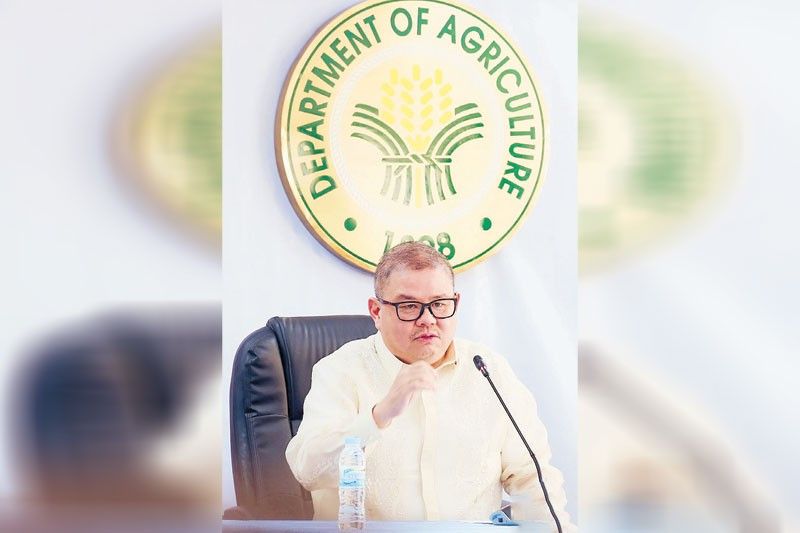Notes on the beat: A look at the DA’s dream team

MANILA, Philippines — Dream Team. It’s the nickname of what has been considered as perhaps the greatest basketball Olympic team ever formed.
It was in 1992 when the “Dream Team” became a reality: the first team to be fielded by the USA composed of active, professional National Basketball Association players – Jordan, Pippen, Robinson, Bird, Ewing and so on.
And that term has been used in various fields and disciplines to describe a team stacked with unprecedented caliber in talent and skill.
It’s also a term that the current Department of Agriculture (DA) leadership is describing itself.
Francisco Tiu Laurel Jr., the fishing tycoon-turned-agriculture secretary, has formed the biggest leadership roster in the department’s history – 13 undersecretaries and 13 assistant secretaries.
The team is composed of technocrats, returning agriculture officials and private stakeholders from retired technical people to former industry leaders.
This mix of officials, Tiu Laurel points out, is necessary for the department to attain a whole-of-nation approach in tackling the problems of the country’s agriculture sector.
Run it like a business
Some of the undersecretaries attest to Tiu Laurel’s wisdom. One undersecretary said the Secretary wanted to bring his “business” or “private sector” style of management to the bureaucracy by designating specific people to every critical line of operations.
“He wants to run it like a business, like a corporate entity. There is an accountable person per portfolio,” Christopher Morales, undersecretary for rice industry development, said.
“We are like small business units,” Cheryl Marie Natividad-Caballero, undersecretary for high value crops, said.
And this policy mindset is the primary reason why the DA has a record number of undersecretaries and assistant secretaries today.
“We have a huge coverage and there is somebody that should focus on each area,” Tiu Laurel previously said.
Indeed, the DA is one of “most complicated” agencies in the bureaucracy. It has nine attached bureaus (from training, soil to fisheries and livestock), eight attached agencies (from credit, pesticide to carabao and fibers) and nine attached corporations (from tobacco, dairy to sugar and irrigation).
During the early days in office, Tiu Laurel turned to former agriculture chief Luis Lorenzo Jr., who like himself is also a businessman, for advice on how to run the department, according to sources.
More meetings, faster actions
Government insiders said meetings have been more frequent within the DA leadership akin to business meetings of corporate firms. And these meetings which have been described as “boardroom style” last more than five hours, forcing the leadership to cut it to three hours.
One of the differences with the meetings at the DA today is that they are more results-oriented, sources said. People say that Tiu Laurel is not a micromanager.
Undersecretaries and assistant secretaries have the full trust of the agriculture chief when it comes to implementing their concerned programs and projects. Tiu Laurel gives the greenlight once the proposed programs and projects are sound and feasible to uplift the concerned agriculture subsector.
What Tiu Laurel is mindful of, however, are the results. Like companies, each undersecretary office is evaluated through a key performance indicator.
The DA leadership has also established a regular meeting with industry stakeholders, serving as a direct line between industry groups and the government. Issues in these meetings vary far and wide.
The industry players are able to submit their recommendations directly to Tiu Laurel, who from time to time adopt them as policies in the department. One of which was the temporary import ban on onions.
On top of its huge leadership team, the DA continues to collaborate with the Private Sector Advisory Council (PSAC) that advises President Marcos on various issues, including agriculture.
Where’s who and who’s who?
“Where is the office of [insert an Undersecretary or Assistant secretary]?”
This was one of the common questions asked around the DA compound during the first few months of the current leadership.
Well, it is natural for leadership reorganization to move spaces. What was uncommon, however, was that nobody exactly knew where the new officials were holding office physically. Much more, if they are 10… 15… 20... 23 undersecretaries and assistant secretaries.
Officials had to make do with whatever space was available to them given the limited offices in the DA. Some of the officials are holding office in attached bureaus or agencies of the DA adjacent to the main compound.
One ranking official even joked about it: wala pa nga akong opisina. Another one said: wala pang kuryente sa office ko.
The “moving in” season in the DA compound continues even until today.
Another birth pain of the current leadership is the overlapping of roles and functions.
Tiu Laurel admits that given the number of undersecretaries he has, there would be confusion and overlapping regarding certain issues and programs.
But undersecretaries interviewed by The STAR noted that overlapping of duties and concerns is unavoidable.
But what is unavoidable? Collaboration and teamwork, they say. And this is how they iron out differences they have to ensure smooth and efficient collaboration and implementation of the department’s projects and programs, sources said.
The returning class
For returning DA officials, it was the vision of President Marcos and Tiu Laurel for the agriculture sector that convinced them to stay or return to the DA.
“I am kind of optimistic because the current administration, particularly the President and the Secretary, has real bias for the farmers,” Asis Perez, undersecretary for policy and planning, said.
“The decision of the administration really is in a way gearing toward self-sufficiency. Kung ganoon ang takbo, eh syempre, sama ka diba?” Perez, a former head of the Bureau of Fisheries and Aquatic Resources, added.
Joining Perez in the returning class of officials are Morales, Natividad-Caballero and Allan Umali (undersecretary for administration).
Morales has been in government service for almost 27 years. He was away for four years from the agriculture department as he served as assistant secretary at the tourism department from 2019 to 2023.
Natividad-Caballero first became an undersecretary during the second term of William Dar as agriculture chief during the Duterte administration. She exited the DA after Dar’s term ended.
Umali previously served as assistant secretary handling the same portfolio during the leadership of Proceso Alcala.
From outside and within
Seasoned government officials from different departments outside and within the agriculture portfolio have also joined the undersecretary ranks.
Long-time National Economic and Development Authority assistant secretary Mercedita Sombilla joined the agriculture department at the turn of the Marcos Jr. administration as an agriculture undersecretary.
Sombilla first handled the policy and planning portfolio during the tenure of President Marcos as agriculture chief. She is now tasked to oversee the attached bureaus of the department.
Former Department of Budget and Management director Nora Oliveros has also joined Tiu Laurel’s team as undersecretary for finance. In the past, there was only one undersecretary handling both administration and finance.
Former BFAR official Drusila Bayate is now the undersecretary for fisheries while Zamzamin Amputan, who was appointed undersecretary in 2019, is the undersecretary for BARMM.
Agnes Catherine Miranda, who has been in government service for nearly three decades, most of which with the DA, is now the undersecretary overseeing the department’s attached agencies and corporations.
From private to public
Former lawmaker and governor Deogracias Victor Savellano is one of the first appointees of the agriculture department, tasked to handle the livestock portfolio.
There are also first time agriculture officials like Roger Navarro who has been a corn industry group leader for decades having been an official of the Philippine Maize Federation Inc. (PhilMaize).
He first joined the government as special assistant to former National Food Authority administrator Roderico Bioco, who was also a former official of PhilMaize.
Navarro said he accepted the challenge to become an undersecretary to be able to experience first-hand how the bureaucracy works, having been on the other side of the fence all this time.
He has been tasked to handle one of the most critical portfolios in the department: operations. For him, it is an opportunity to make their advocacies in the private sector a reality now that he is part of the government.
Wrapping up the undersecretary team are Jerome Oliveros (Special Concerns and for ODA - Foreign Aid/Grants) and Alvin John Balagbag (DA Inspectorate and Enforcement and Chief-of-Staff).
The second 13
The half of Tiu Laurel’s team are perhaps known as the second 13. Coincidentally, there are also 13 assistant secretaries in the department.
Almost each undersecretary has an assistant secretary for the portfolios and programs that they are in charge of.
Like the undersecretaries, the roster of assistant secretaries are a mix of veteran officials and first-timers. There are also new portfolios for assistant secretaries such as exports, national task force on west philippine sea, logistics and two items related to livestock and poultry.
Seasoned agriculture officials Noel Padre (Planning and Project Development), Arnel de Mesa (Special Concerns and for ODA - Foreign Aid and Grants / Spokesman), Paz Benavidez II (Policy and Regulations), Telma Tolentino (Finance) and U-Nichols Manalo (Operations) lead the assistant secretary roster.
Veterinarians Constante Palabrica and Benjamin Albarece have joined Tiu Laurel’s team as assistant secretaries. Palabrica is in charge of swine and poultry while Albarece oversees ruminant livestock, both portfolios are new to the department.
Palabrica was a former technical director of Robina Farms of conglomerate JG Summit Holdings Inc. with over 40 years of private sector experience.
Albarece has been serving as adviser for various entities on livestock and poultry, including a stint as a senior adviser on livestock of the DA from 2003 to 2005. He was also a former president of the Federation of Cattle Raisers Association of the Philippines.
Allen Kristopher Anarna, a lawyer and partner of Anarna Law firm, is in charge of administration while Genevieve Velicaria-Guevarra, the sister of Communications Secretary Cheloy Velicaria-Garafil, handles the consumer affairs as well as legislative affairs.
Exporter Philip Young is tasked to oversee the export development unit of the DA while Daniel Alfonso Atayde is in charge of handling the logistics portfolio, one of the key units identified by Tiu Laurel as a priority.
James Layug, who was appointed assistant secretary in 2022, is now the assistant secretary for Executive Order 70 series of 2018 and for the National Task Force for the West Philippine Sea. Carlos Carag, assistant secretary for DA inspectorate and enforcement, completes the team.
Six months in the making
It took at least six months to “formally” form the team since the players had to wait for their appointment papers from Malacanang. But even before the appointment papers were released, Tiu Laurel’s team had been silently working at the department.
As early as a month after Tiu Laurel became agriculture chief, some of his handpicked officials have been at the DA already, shadowing and overseeing their eventual portfolios.
Game time
By April, the team was 90 percent complete. Last month, it was finally game time.
For some agriculture industry players, the number of DA officials is not a concern, or at least not yet. What matters most, they say, is that the department delivers on its promise of improving farmers’ welfare.
If Tiu Laurel’s team would be able to surpass the achievements of his predecessor, then having such a number of undersecretaries and assistant secretaries is perhaps justified, sources told The STAR.
They added, however, that they would not hesitate to criticize and call out the current DA leadership if they fail.
Indeed, the stakes in agriculture far exceed that of the Olympics. It is not just pride, honor or prestige that is on the line. It is the security of a nation. Food security.
And only time will tell if the “dreams” of Tiu Laurel’s team for a better agriculture sector would become a reality for Filipino farmers and consumers alike. Game on.
- Latest
- Trending




























